smapdiage9
Well-Known Member
- Joined
- Mar 14, 2009
- Messages
- 442
- Reaction score
- 3
Disclaimer: This will be my long term build thread, and this one is at the bottom of the pile so it'll take a minute! Since this is a new and relatively exciting kit with little info online I figured someone else might want to see what it includes.
I've been under 10-12k waivers for a few years so despite my love of other people's high performance flights I have gotten quite a pile of unbuilt minimum diameter birds. As it turns out I have to move to Kansas later this year, and since I understand that there are a couple of launches in that region with waivers above 12k it seemed justifiable to buy yet another damn set of composite tubes and plates.
The Falcon is a 75mm/3" carbon fiber and fiberglass minimum diameter rocket designed for head end deployment. The kit is pretty minimalist but it's not exactly uncharted territory to figure it out; build an avionics setup, shove a parachute in the nosecone, and glue the fins on with the recommended scotchweld right? Well I'd like to be a tad more deliberate about things as I stick this one together, so before anything gets sanded or glued there are a few problems I'd like to solve:
[] Get an accurate sim file together (me)
[] Figure out a recovery system that will be appropriate to altitudes flown (Review Jim
Jarvis' document on BP charge effectiveness at higher altitudes, see what other people have done for shear pins in this performance range)
[] Design and manufacture an electronics sled and arrangement to facilitate dual redundancy and tracking in an elegant manner (me)
[] Do some further research on the specific concerns associated with the intended adhesive and materials (me doing research, hopefully someone else already did the heavy lifting)
[] Motor forward bulkhead/retainer (probably just copy the standard coupler and pem nuts design)
The important problems I can hopefully ignore (because this kit was designed by someone who knows better) are aerodynamic stresses like fin flutter and peel strength of the tube.
Here's what your money gets you:
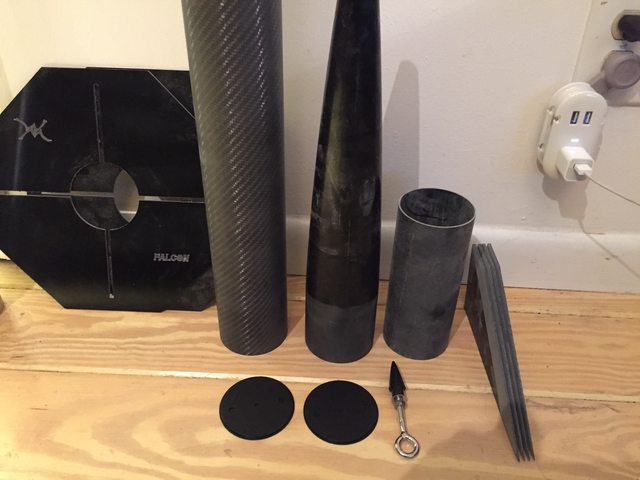
Here's what everything weighs (pre-wash/sanding):
52" body tube
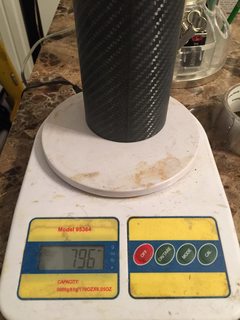
7" fg coupler
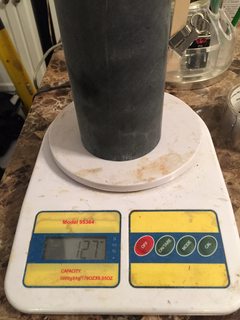
Nosecone (no tip)
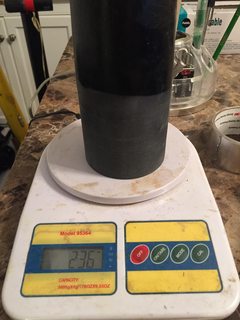
4 fg fins:
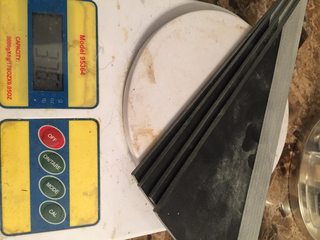
They were 93,94,95,95.
NC Tip and hardware:
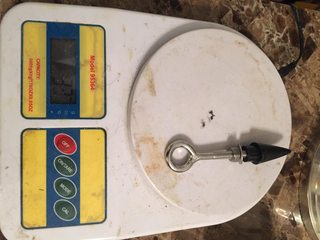
Bulkplates:
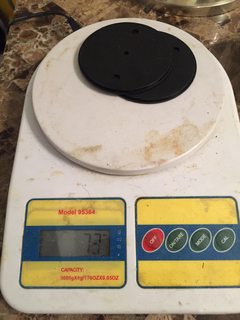
Adding it up:
73g 2 aluminum bulkplates
796g 52" carbon fiber body tube
236g nosecone without tip
33g nosecone tip, washer, nut, and 1/4" welded eyebolt
127 7" fiberglass NC coupler/avionics bay
376g 4 fiberglass fins 3/16" at root, no taper but steeply beveled
That's a total of 1641g or 3.6lbs. I think the advertised predicted weight was a bit under
3lbs so we're about 270 grams heavy give or take. It's still light enough for me!
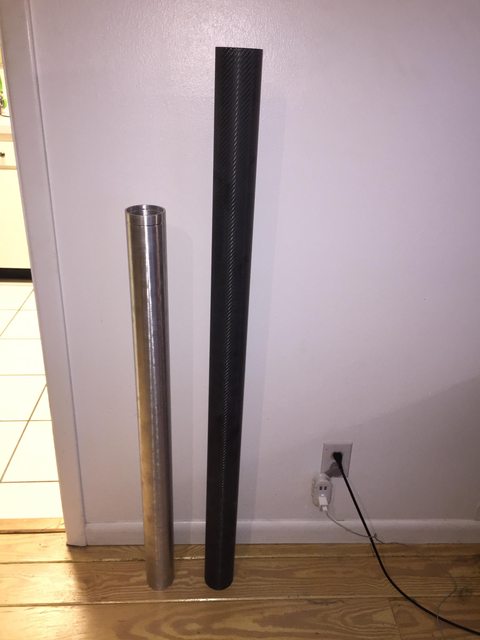
My 52" body tube is about 52 1/8". Here it is next to a 75/7600 case.
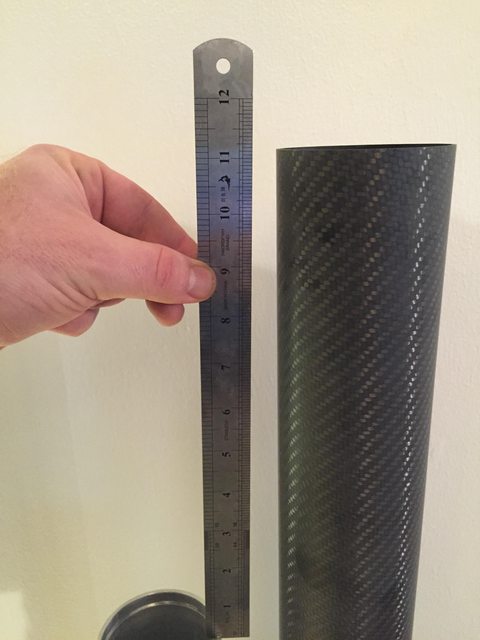
Just over 11" between the top of the motor and the end of the tube (ignoring the extra distance if a thrust ring is used). Assuming at least half of the coupler sticks down into the body tube we're probably going to have about 6" of space for the drogue, harness, hardware, and motor bulkhead. The unmeasured eyeball-accurate sim file I made based on the spec sheet called it a no motor weight of 7.2lbs going to 42k on an M2245. Once I get a better file together I'll attach it here.
Now it's back to my pile of Blackhawks and Mongeese so I can make smaller scale mistakes before destroying this one!
I've been under 10-12k waivers for a few years so despite my love of other people's high performance flights I have gotten quite a pile of unbuilt minimum diameter birds. As it turns out I have to move to Kansas later this year, and since I understand that there are a couple of launches in that region with waivers above 12k it seemed justifiable to buy yet another damn set of composite tubes and plates.
The Falcon is a 75mm/3" carbon fiber and fiberglass minimum diameter rocket designed for head end deployment. The kit is pretty minimalist but it's not exactly uncharted territory to figure it out; build an avionics setup, shove a parachute in the nosecone, and glue the fins on with the recommended scotchweld right? Well I'd like to be a tad more deliberate about things as I stick this one together, so before anything gets sanded or glued there are a few problems I'd like to solve:
[] Get an accurate sim file together (me)
[] Figure out a recovery system that will be appropriate to altitudes flown (Review Jim
Jarvis' document on BP charge effectiveness at higher altitudes, see what other people have done for shear pins in this performance range)
[] Design and manufacture an electronics sled and arrangement to facilitate dual redundancy and tracking in an elegant manner (me)
[] Do some further research on the specific concerns associated with the intended adhesive and materials (me doing research, hopefully someone else already did the heavy lifting)
[] Motor forward bulkhead/retainer (probably just copy the standard coupler and pem nuts design)
The important problems I can hopefully ignore (because this kit was designed by someone who knows better) are aerodynamic stresses like fin flutter and peel strength of the tube.
Here's what your money gets you:

Here's what everything weighs (pre-wash/sanding):
52" body tube

7" fg coupler

Nosecone (no tip)

4 fg fins:

They were 93,94,95,95.
NC Tip and hardware:

Bulkplates:

Adding it up:
73g 2 aluminum bulkplates
796g 52" carbon fiber body tube
236g nosecone without tip
33g nosecone tip, washer, nut, and 1/4" welded eyebolt
127 7" fiberglass NC coupler/avionics bay
376g 4 fiberglass fins 3/16" at root, no taper but steeply beveled
That's a total of 1641g or 3.6lbs. I think the advertised predicted weight was a bit under
3lbs so we're about 270 grams heavy give or take. It's still light enough for me!

My 52" body tube is about 52 1/8". Here it is next to a 75/7600 case.

Just over 11" between the top of the motor and the end of the tube (ignoring the extra distance if a thrust ring is used). Assuming at least half of the coupler sticks down into the body tube we're probably going to have about 6" of space for the drogue, harness, hardware, and motor bulkhead. The unmeasured eyeball-accurate sim file I made based on the spec sheet called it a no motor weight of 7.2lbs going to 42k on an M2245. Once I get a better file together I'll attach it here.
Now it's back to my pile of Blackhawks and Mongeese so I can make smaller scale mistakes before destroying this one!
Last edited:




